Joan Prats Gallery is present for the second year at Paris Photo.
We present works by Hannah Collins (London, 1956), Chema Madoz (Madrid, 1958), Caio Reisewitz (São Paulo, 1967).
PARIS PHOTO Stand D17.
Grand Palais. 08-11 NOV 2018
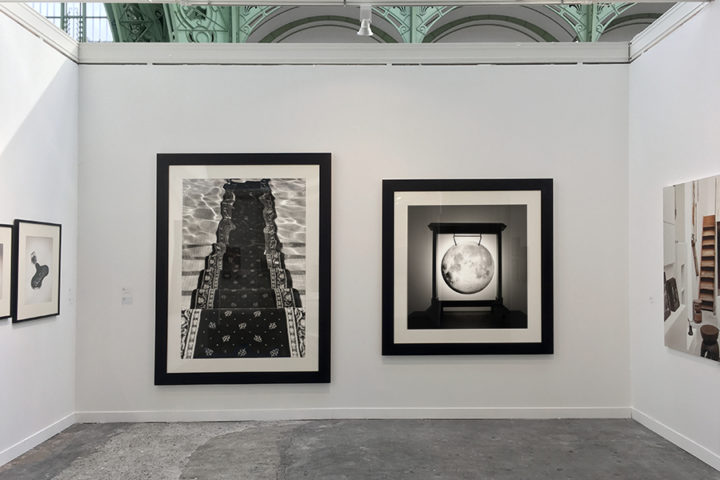
Joan Prats Gallery is present for the second year at Paris Photo.
We present works by Hannah Collins (London, 1956), Chema Madoz (Madrid, 1958), Caio Reisewitz (São Paulo, 1967).
PARIS PHOTO Stand D17.
Grand Palais. 08-11 NOV 2018
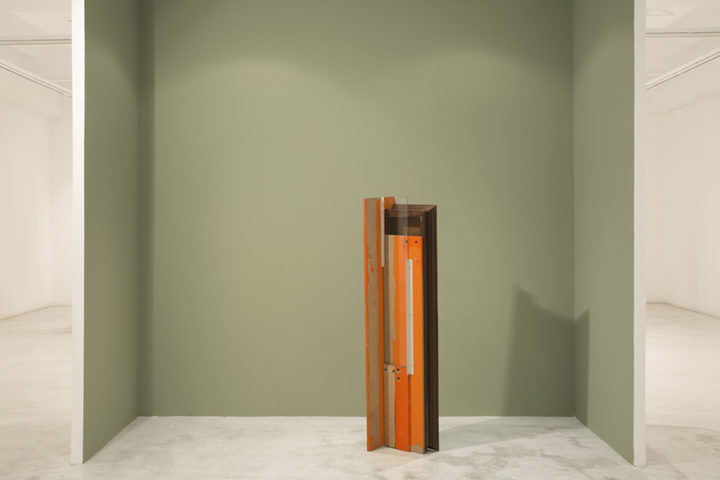
Opening: 26.9, 7 pm
Exhibition October – November
We are pleased to announce Pedro Cabrita Reis´ first exhibition in our gallery, presenting a selection of recent works of sculpture, paintings and photography.
The work by Cabrita Reis includes a great variety of media, varying from photography and drawing to large-scale paintings and sculptures, composed of industrial and often found materials, as in the case of Floresta, 2017, which we are presenting in the exhibition, and they frequently reach architectural dimensions. In this exhibition, we encounter works made of different materials such as steel, wood, aluminium, glass, enamel, bronze and acrylic. In the words of the artist, “Everything that exists is material which can be used in the construction of a work of art”. Consequently, he does not establish hierarchies between the objects and materials he work with. For Cabrita Reis, the material is the way of looking and thinking that changes everything.
Cabrita Reis´ work investigates the limits between architecture, sculpture, painting and photography, while he primarily considers himself a painter. His work is three-dimentional, often very personal and aim to alter, define or question the limits of spatiality. The meaning remains mysterious and fascinating. The contemplation takes form in the material, reaching the spectator, provoking new questions and linking imagination to experience.
Pedro Cabrita Reis began his career in the 1980s, as one of the most distinguished artists of his generation, introducing an universe of archaic and mythical references, collective memory and individual revelation. His works have had a great impact on the Portuguese and international culture, incorporating, into the more radical modern heritage, the possibility of returning to more traditional artistic disciplines: drawing, painting and sculpture.
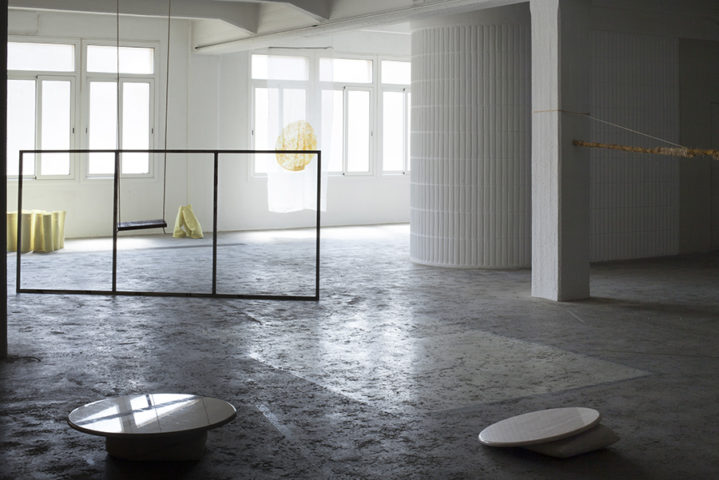
JOAN PRATS warehouse, Passatge Saladrigas 5, Barcelona
By appointment at 932 160 284
Exhibition: 05/09/2018 – 26/10/2018
As part of artnou, Galeria Joan Prats presents the work of two young artists, Aïda Andrés Rodrigálvarez (Barcelona, 1985) and Pablo del Pozo (Badajoz, 1994).
Their works deal with the relationship that is established between the individual and the space surrounding, from an everyday point of view. The territory and nostalgia, the search for a refuge, the passage of time are important topics in their work, together with the environment. We will show installations of the two artists, that have been made from found objects and materials exposed to the elements.
Aïda Andrés Rodrigálvarez is interested in the impression that light, the environment and the passage of time is producing on paper. The techniques of lithography and pinhole photography allow her to work with a dilated temporality, as well as to investigate the color. In her artistic practice, paper and fabrics are left at the mercy of the elements, thus becoming photosensitive materials.
On the other hand, the works by Pablo del Pozo have a strong autobiographical character, linked to the experiences of the artist. The feeling of belonging to a place, displacement and nostalgia are subjects that concern him. From the characteristics of the materials used (clay, plaster, pigments and also found objects), he seeks to talk about the precariousness of life, thus generating a reflection on the daily reality.
Aïda Andrés Rodrigálvarez (Barcelona, 1985) lives and works in Barcelona. She owns a Master’s Degree in Artistic Productions and Research (2015-16) and a a Degree in Fine Arts (2014) from the University of Barcelona. She have also an Architecture Degree from the ETSAB, Barcelona (2010). She has individually exhibited at Fundació Arranz-Bravo at L’Hospitalet de Llobregat (2017), in the Acadèmia de Belles Arts de Sabadell (2016) and at Tinta Invisible, Barcelona, (2014). She has been granted by Institut Ramon Llull for the Jeune Création Européenne Biennale, has received the production grant Felicia Fuster (2018), Guasch-Coranty (2016) and the prize Arranz-Bravo (2017).
Pablo del Pozo (Badajoz, 1994) lives and works in Barcelona. He owns a Degree in Fine Arts (2014) from the University of Barcelona (2017). He has individually exhibited at Centre Tecla Sala de L’Hospitalet de Llobregat), at Le Beffroi de Montrouge, París (2017) and at the Acadèmia de Belles Arts de Sabadell (2016). He has been selected to the Biennal de Valls, the Guasch-Coranty prize (2017) and to the Jeune Création Européenne Biennale (2017-8) with exhibitions in several European cities like Montrouge, France (2017); Hjørring, Denmark; Cēsis, Latvia; Cluj, Romania (2018); Como, Italy; Figueres and Amarante, Portugal (2019). He also has been granted by a production scholarship by the Sala d’art Jove de la Generalitat (2017), where he will show during June 2018.
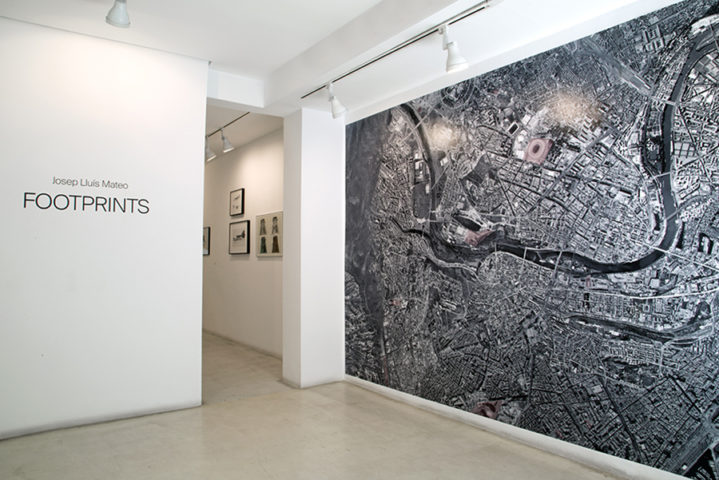
Opening June 21st, 7 pm 22/06/2018 – 14/09/2018
Galeria Joan Prats presents Footprints, the first exhibition of the architect Josep Lluís Mateo.
Through a selection of works and projects, the exhibition approaches, in a non-chronological way, the trajectory of Mateo, looking for ways to narrate architecture from within the topics inherent in its practice. Mateo’s architecture is characterized by the inheritance of modernity, which is interested in the pursuit of light, an intense dialogue with the context, and the connection between the idea and the material. His projects are reflective and strategic; they speak about space while taking care of the relation between the mineral and the vegetable.
Scale models, photographs, videos, collage and sketches make it possible to apprehend the complexity of his creative and constructive process. We find, for example, historical materials of emblematic projects such as the urbanization of the medieval town of Ullastret, mockups that reflect the development of a constructive concept, as is the case of the facade of the International Convention Centre of Barcelona, or photographs that show the interaction of the work with its surroundings.
“A journey, a path, is made up of a succession of points, of steps, of footprints, which, viewed as a whole, indicate a direction, reveal (or not) their meaning.
Here, without pretending to draw the line, we show a few points, some footprints, in our journey.
So others can draw it.
These moments are explained by the materials that produced them.
Although architecture is a complex phenomenon in its result (it deals with matter, space, use, economy…), in its production there is an initial moment of synthesis that generates the energy needed to develop it.
There is also a final moment that synthesises, in a second, like a flash, all the effort that has been made.
To show these initial materials, which condense the idea, and some final documents that shed light on the reality, is the purpose of this exhibition.”
Josep Lluís Mateo
The exhibition highlights the work of photographers who accompany the vision of Josep Lluís Mateo as Aldo Amoretti, Gabriele Basilico, Jordi Bernadó, Jan Bitter, Luc Boegly, Ferran Freixa, Adrià Goula, Albert Masias and Xavier Ribas.
Josep Lluís Mateo is an architect from the Escola Tècnica Superior d’Arquitectura of Barcelona (ETSAB) and doctor “cum laude” from the Universitat Politècnica de Catalunya (UPC). Since 2002, he is Professor of Architecture and Design at the ETH-Eidgenössische Technische Hochscule Zürich. He has given conferences and courses in the main academic and professional institutions of the world, among others: visiting academician in the J.P. Getty Center in Los Angeles, visiting professor at Harvard University-GSD and at AHO Oslo.
In his career, awarded with the A+2011 Prize for the best professional career, some works standout such as the urbanization of the medieval town of Ullastret, Girona (Santander Biennial Award 1991); the plan for the organization of the sports area of the Universitat Autònoma of Barcelona (special mention FAD Awards for Architecture and Interior Design 1993); the housing complex on the Borneo pier in Amsterdam (CEOE Award 2001); the single-family house in Mallorca (Prize for the Best Work in the section of single-family housing 1997-2001 granted by the Official College of Architects of the Balearic Islands); the CCIB – International Convention Centre of Barcelona (Top International Purpose Award 2009 – C&ITE Magazine and Gold for the Best Convention Centre Abroad 2010 – M&IT Industry Awards); the Headquarters of the Deutsche Bundesbank in Chemnitz (2004, Germany); the Sant Jordi Residence Hall in Barcelona (Archizinc Trophy 2008); the WTC Almeda Park building in Cornellà, Barcelona (A+ Award for architecture for the work 2010); La Factory, office building in Boulogne-Billancourt, Paris (NAN Architecture and Construction Award 2010); the Headquarters of the company PGGM in Zeist, Holland (NAN Architecture and Construction Award 2011); the Filmoteca de Catalunya (2012, Barcelona); the Centro de Cultura Contemporânea, as a culminating piece of the renovation of the historical centre of Castelo Branco (2013, Portugal); and Bayonne. Entrée de ville, urban redevelopment of the urban front of the Adour river, including building project (2016, France). His work has been widely published and exhibited in the MoMA (New York, 2006), in the Pavillon de l’Arsenal (Paris, 2009), the Venice Biennial (2012) and in the Galerie d’Architecture (Paris, 2013), among other places.
To provide you with more information and images, please contact galeria@galeriajoanprats.com
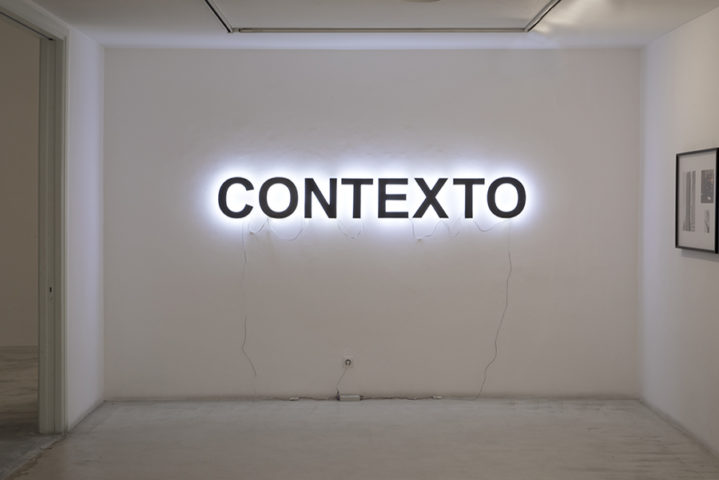
Galeria Joan Prats presents the exhibition Edicions II by Muntadas, which gathers a selection of serial works the artist has developed since 2003 up to the present day in different formats: publications, prints, videos, objects, installations and other graphic materials. This exhibition completes the work started in the exhibition Edicions, made at Galeria Joan Prats in 2003.
«The first time Muntadas talked to me about the exhibition Edicions II at the Galeria Joan Prats, he referred to it as an “exhibition of deltas”. I asked him to elaborate: “my projects are one, they are units. But these units diversify into huge quantities of postcards, there could be up to 100.000 postcards, and could even include 17 metal plaques distributed throughout the city in the form of signage, or a web page. So, the project finally appears as the sum of three collections of remains; that is of deltas” (…)
Editions allowed Muntadas to achieve a more porous and plural circulation by its multiplication and intervention capacities across diverse media and in different time frames. While his projects usually consist in one video, one installation, or one urban intervention, his publications are rarely made up of a single unique element (…)
A truly genuine notion of project has also emerged throughout Muntadas’ career. The artist tackles the project, on the one hand, as the logic behind a series of procedures, based on the repetition of processes and strategies and on the other, the project defines itself following the logic of a work in progress, generating moments of aperture. In this way, the notion of project, as Muntadas states, has allowed him to depart from a type of intuitive and immediate practice while helping him to structure flexible environments, open to unpredictability, developing platforms to work in the long run (…)
The editorial work and the publications is where Muntadas has experimented more precociously and with more intensity than in any other medium the collaborative methods that have ended up impregnating the whole of his work. Here is where one finds the deployment of strategies that catalyse translation no longer, as just a metaphor, so much as in particular a process of bidirectional exchange.»
Fragments of Oriol Fontdevila’s text Piscine Obliviousness. Amphibious editions, from the exhibition catalogue.
Muntadas, born in Barcelona and living in New York since 1971, was a pioneer of video and installation in the mid-seventies, and continued working with photography, video, installation, audio, and urban interventions. Iterations of his iconic projects, such as Between the Frames: The Forum (1983-1993), The Board Room (1985), and the on-going series On Translation (1995- …) and The Construction of Fear (2008- …) – have been exhibited in institutions and galleries of the USA, Latin America, Europe and the Mid-West. Muntadas participated in the Documenta’s 1977 and 1997 editions, the Whitney Biennial of 1991, the Bienal de São Paulo of 1983, the Bienal de La Habana of 2000, the Taipei Biennal of 2002, the Gwangju Biennale of 2004, the Instanbul Biennal of 2011, and the Paris’ La Triennale of 2012. In 2005, he represented Spain in the Venice Biennale, where he created an integral project about the architectonical evolution of the Biennale throughout its history. His works have been included in exhibitions at MACBA, Barcelona; Laboratorio Arte Alameda, Mexico City; Weserburg Museum, Bremen; Espacio Fundación Telefónica, Buenos Aires; Württembergischer Kunstverein, Stuttgart; and Estação Pinacoteca, São Paulo. Since 2011 he has been working on the project Asian Protocols, presented to the public for the first time at Total Museum of Seoul (2014), and for the second time at 3331 Arts Chiyoda of Tokyo (2016). The next step of the project will be its development in China.
A catalogue has been edited especially for the exhibition
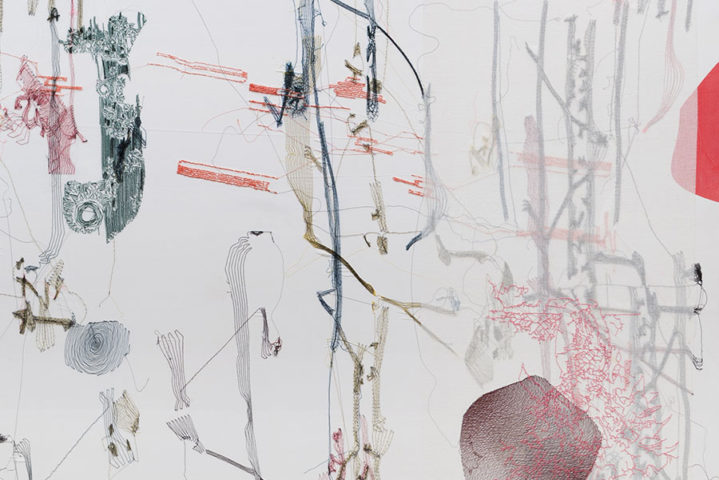
We present Phasma, the seventh exhibition by José María Sicilia in Galería Joan Prats, where we show his recent work, with abstract pieces that incorporate fabrics and embroidery and whose shapes come from sonograms.
The word that entitles the exhibition, Phasma, of Greek origin, designates the specters and apparitions and refers, as described by the artist, to “something that appears and disappears, a butterfly that goes by flapping its wings” and that “speaks of the light as a fold”.
In the exhibition, together with the Phasma series, started in Japan, we find the series of El Instante, collages made from drawings of the last ten years, and works from the series La Locura del ver. The creation process of this last series is linked to a sonographic technology that results from an experiment carried out by Thomas Young in 1801, which allowed for the detection of the wave nature of light through its diffraction across two networks successively distanced from a luminous source. This experiment serves as a starting point for a software that allows Sicilia to decompose the sound in order to create cartographies of lines and shapes, some drawings, painting, collage and embroidery compositions that result in the works of La Locura del ver.
This technology gives José María Sicilia a tool to reach a new depth. In this new development of his work we find everything that was already present in his previous artistic evolution: the strength of color, the movement of light, a fondness for the organic and the process of unification and opposition that, since the eighties, his painting have shown. His first production had a strong expressionist character and deepened in the monochrome of white. Later on, his career is marked by the discovery of wax as a material, by the appearance of flowers, beehives and also by photography. Sicilia is a restless creator who has based his work on the questioning of shape. He is an artist who interrogates, who does not accept molds and feels the need to break the formats, summoning the emotion of the spectator.
José María Sicilia (Madrid, 1954) lives and works in Madrid. He has recently exhibited in Museo Casa de la Moneda and Calcografía Nacional, Madrid (2017); Musée Delacroix, Paris (2015), Palacete del Embarcadero, Santander (2014); Matadero, Madrid and Fukushima Prefectural Museum of Art (2013); Hospital de la Caridad, Sevilla (2012); Maison Erasme, Brussels and Amos Anderson Art Museum of Helsinki (2010); Nagasaki Prefectural Art Museum (2008). His work is present in important public and private collections, among which stand: Centre Georges Pompidou, Paris; MOMA, New York; Fundació ‘la Caixa’, Barcelona; Colección Banco de España, Madrid; Collection Ville de Paris; MACBA, Barcelona; Galleria d’Arte Moderna, Torino; MNCARS, Madrid; Museum of Modern Art, Gunma, Japan; National Gallery of Australia, Canberra; Solomon R. Guggenheim Museum, New York; The New York Public Library, New York.
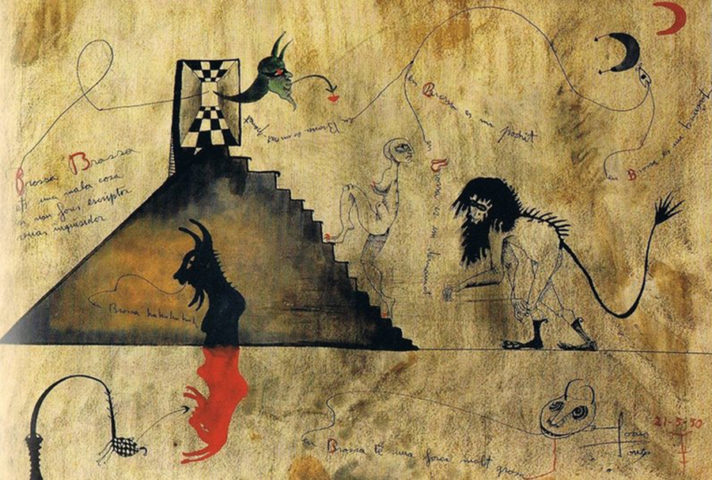
We are pleased to present the exhibition dedicated to Joan Ponç and Joan Brossa, to be opened on Thursday, November 30rd, and where we will show works by two of the most significant artists in the recovery of avant-garde art in our country after the civil war, united by a creative and personal affinity from the late 40s to the early 50s and also linked to the history of Galeria Joan Prats, where they both would exhibit on several occasions.
In 1982, Joan Brossa showed for the first time in his exhibition at Galeria Joan Prats his object and visual poems, poems that he was making since 1954 and that were by then practically unknown by the public. Later, they would be shown in other exhibitions at the gallery in Barcelona (1989, 1995, 1997) and in New York (1989), and at the Basel Fair (1989). On the other hand, Joan Ponç began his collaboration with Galeria Joan Prats in 1978, with the exhibition Fons de l’ésser. He also exhibited in 1983, Nocturns, in 1987 with drawings from Pre-Dau Al Set period, in 1994 and 1996 with drawings from Suite Geomètrica and in 1980 at the FIAC art fair in Paris.
As Arnau Puig says in the text written for this exhibition, “A temperament and character of the dimensions of Brossa was almost destined to come across someone like Joan Ponç, who came down from the clouds”. This taste for magic, divination and the occult would be one of the points of union between the two artists, who met in 1946. That year they would publish together with Arnau Puig and Enric Tormo the only issue of the magazine “Algol”, which wanted to be a revulsive in front of immobilism and the loss of idealism of their contemporaries. They proposed a renewal of the look that is also visible in the monotypes that Ponç made to accompany the issues of the magazine and that moves away from the predominant naturalist figuration in Spanish art of the time.
In addition to this interest in new artistic forms, the works by Brossa and Ponç coincided thematically in a concern and criticism of society, along with an interest in popular culture, theatre and magic that we already pointed out. That’s why, in those years, collaborations between the two took place: the unpublished book Parafaragaramus (1948), two issues of the magazine “Dau Al Set” (January, 1949 and an unpublished one), the book Em va fer Joan Brossa (1951), where a portrait of Joan Brossa by Joan Ponç appears, considered the most direct and sincere portrait the poet has ever had. The Brossa-Ponç relationship was also reflected in the poems by Brossa alluding to Ponç and in several Ponç drawings: the Dibuixos podrits (1947) and the Metamorfosis (1947), the Joan Brossa-Joan Ponç suite (1947), the cover of the book Dragolí by Brossa (1950), or the gouache Brossa, Brossa (1950), that we show in this exhibition.
Brossa and Ponç were at the time two standard bearers of the aesthetic renovation, following the steps of J.V. Foix and Joan Miró. Brossa, who had met Miró in 1941 through the hat maker and patron Joan Prats, at J.V. Foix’s home, would introduce them Joan Ponç. “Dau Al Set” would help to restore bridges with the avant-garde of ADLAN, promoted by Joan Prats and Joaquim Gomis, and GATCPAC.
After this period of affinity and creativity, in 1953 Joan Ponç went to Brazil, and each artist continued his own journey. On his return to Catalonia, in 1962, Brossa was already very far from magic surrealism and was moving by an antipoetry linked to reality while doing plastic experiments of what would be his visual poetry. Their bond would be diluted. For Brossa, Ponç would always be linked to “Dau Al Set”.
This exhibition aims to show the trajectories of the two artists: a first part, with works from the period “Dau Al Set”, the moment of greatest affinity between Joan Brossa and Joan Ponç, and a second part of the exhibition, with later works, that allow to see their evolutions in the plastic field, and that they are reflected in the same way as in the Joan Brossa-Joan Ponç suite (1947).
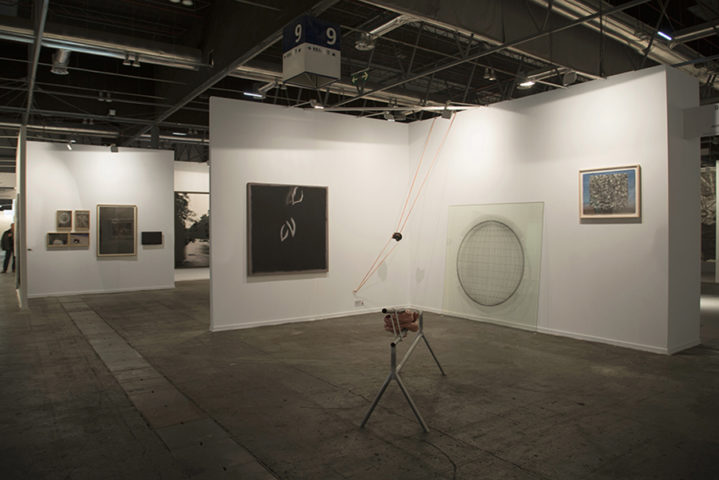
ARCO Madrid. 21/02/2018 – 25/02/2018
CABELLO/CARCELLER
HERNÁNDEZ PIJUAN
LOLA LASURT
PEREJAUME
JAVIER PEÑAFIEL
FERNANDO PRATS
CAIO REISEWITZ
JULIÃO SARMENTO
JOSÉ MARÍA SICILIA
TERESA SOLAR ABBOUD
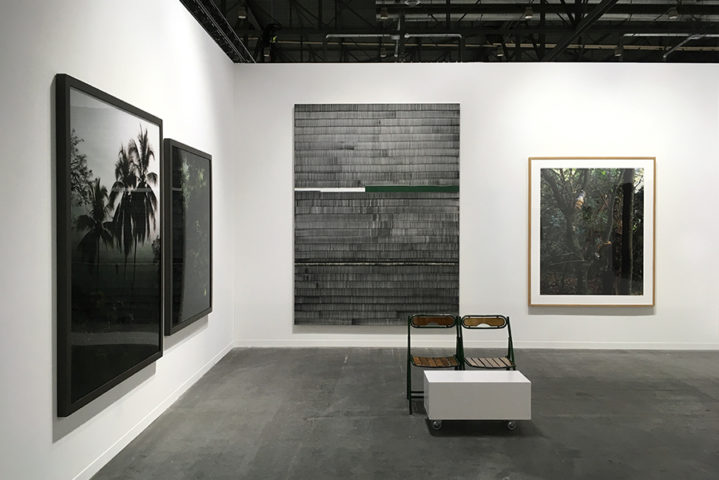
Artgenève 01-04 / 02 / 2018 BOOTH D16
Hernández Pijuan, Perejaume, Ràfols Casamada,
Caio Reisewitz, Juan Uslé